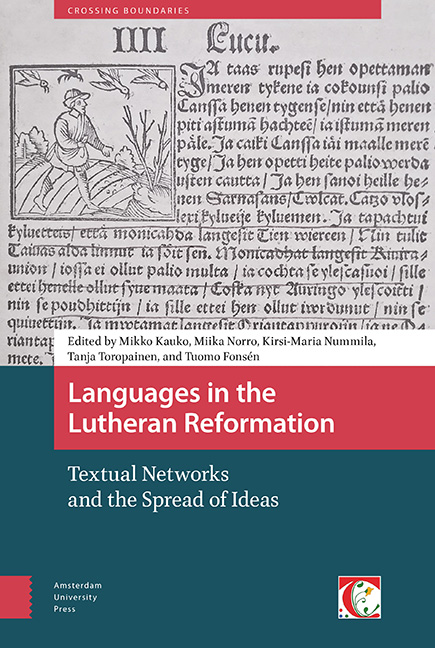Book contents
- Frontmatter
- Contents
- List of Figures and Tables
- Preface
- Introduction
- Part I The Reception of Luther's Ideas and their Influence for the Development of Written Languages
- Part II Effects of Bible Translations on the Evolution of Written Language
- Part III Reuse of (Catholic) Texts after the Reformation
- Part IV Language Contacts and Loanwords
- Index
2 - Linguistic Ideas of the Lutheran Reformation in the Genesis of Literary Estonian
Published online by Cambridge University Press: 21 November 2020
- Frontmatter
- Contents
- List of Figures and Tables
- Preface
- Introduction
- Part I The Reception of Luther's Ideas and their Influence for the Development of Written Languages
- Part II Effects of Bible Translations on the Evolution of Written Language
- Part III Reuse of (Catholic) Texts after the Reformation
- Part IV Language Contacts and Loanwords
- Index
Summary
Abstract
This essay deals with the question of how the ideals of the Lutheran Reformation regarding language usage and translation were put into practice in written Estonian. It focuses on the confrontation between ideals and practical reality. The role of the German language was very strong in the area of contemporary Estonia in early modern times; the elite were German speaking, and this also applied to the Lutheran clergy and those who did the actual translation work. According to the Lutheran ideal, the translation should aim at a language that was understandable to the common people, clear, and expressive. The aims were challenging when the text was translated into a new language that was still in the process of developing – and when the translators were non-native speakers who only had a basic knowledge of the language. The essay deals with these perspectives from the development of written Estonian over a 200-year period, from the early 16th century, at the beginning of the Lutheran era, to the publishing of the first complete Bible in Estonian in 1739.
Keywords: Literary Estonian, Bible and hymn translations
Literary Estonian was born during the two post-Reformation centuries in the process of translating catechisms, pericopes (i.e., sections of the New Testament required for the divine services of the liturgical year), hymns and, most importantly, the Bible. It was purposefully created for written ecclesiastical translation. Some elements of standard ecclesiastical Estonian – the principal terms and formulae of Christian discourse – had probably already taken shape in the Middle Ages in the process of oral communication. However, literary mediaeval Estonian as a written variety did not exist (see also Toropainen in this volume). The first literary standards for written texts in Estonian were created by Lutheran pastors, and, in a relatively short post-Reformation period, a considerable number of written translations were produced. As a result, in the period between the publication of the first book including an Estonian text in 1525, which is not extant but is supposed to have been a Lutheran mass book (Kivimäe 2000), and the publication of the first full Estonian Bible in 1739, linguistic standards for literary Estonian suitable for Bible translation were established.
- Type
- Chapter
- Information
- Languages in the Lutheran ReformationTextual Networks and the Spread of Ideas, pp. 57 - 78Publisher: Amsterdam University PressPrint publication year: 2019



